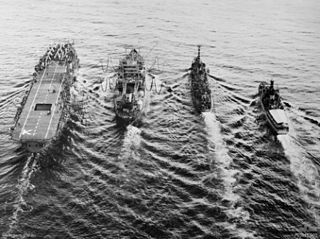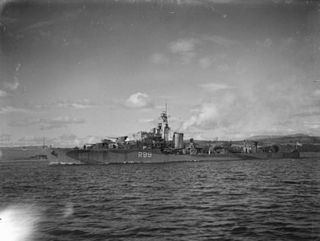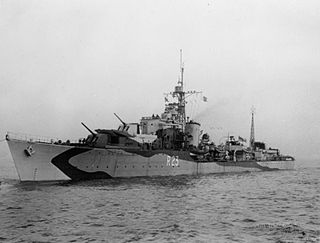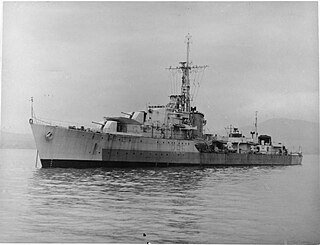
HMS Loch Killin was a Loch-class frigate of the Royal Navy, named after Loch Killin in Scotland. The ship was laid down at Burntisland Shipbuilding Company's yard in Fife on 2 June 1943, and launched on 29 November 1943. She was one of the first vessels armed with the brand new Squid anti-submarine mortar. Decommissioned in September 1945, the ship was put into Reserve, and finally scrapped on 24 August 1960.

ORP Krakowiak was a British Type II Hunt-class destroyer escort, used by the Polish Navy during World War II. Initially built for the Royal Navy, it bore the name of HMS Silverton during British use.
Several ships of the Royal Navy have been named HMS Alliance:

HMS Cawsand Bay was a Bay-class anti-aircraft frigate of the British Royal Navy, named for Cawsand Bay in Cornwall.

HMS Alert a Bay-class frigate of the Royal Navy. She was originally laid down as the Loch-class vessel Loch Scamdale, and re-ordered as Dundrum Bay while building. She was completed as Alert, an Admiralty Yacht for command and gunboat diplomacy duties in the Mediterranean and Far Eastern stations.

HMS Relentless was an R-class destroyer of the Royal Navy that saw service during World War II. She was later converted into a Type 15 fast anti-submarine frigate, with the new pennant number F185.

HMS Urania was a U-class destroyer of the British Royal Navy that saw service during World War II. After the war she was converted into a Type 15 fast anti-submarine frigate and was scrapped in 1971.

HMS Urchin was a U-class destroyer of the British Royal Navy that saw service during the Second World War.

HMS Teazer was a T-class destroyer of the Royal Navy that saw service during the Second World War. She was later converted to a Type 16 fast anti-submarine frigate, with the new pennant number F23.
Four vessels of the Royal Navy have been named HMS Ribble, after the English river:

The Egret-class sloops were a three ship class of a long-range escort vessels used in the Second World War by the Royal Navy. They were an enlarged version of the Bittern class with an extra twin 4-inch gun mounting. They were fitted with Denny Brown stabilisers and the Fuze Keeping Clock anti-aircraft fire control system.

HMS Odzani (K356) was a River-class frigate that served in the Royal Navy.

HMS Hadleigh Castle (K355) was a Castle-class corvette of Britain's Royal Navy.

HMS Nene was a River-class frigate, designed for anti-submarine operations, that served with the Royal Navy during the Second World War. In 1944 she was loaned to the Royal Canadian Navy and recommissioned as HMCS Nene, who returned her to the Royal Navy in 1945. Following the war she remained in reserve until disposed of in 1955.
HMS Meon was a River-class frigate that served with the Royal Navy and Royal Canadian Navy in the Second World War. The vessel was used primarily as a convoy escort in the Battle of the Atlantic, but also took part in the Invasion of Normandy. After the war, the ship was converted to a headquarters vessel for amphibious operations, and saw service in the Persian Gulf from 1952 to 1965, before being scrapped in 1966. She was named for the River Meon in the United Kingdom and was sponsored by the town of Bletchley in Buckinghamshire.

HMS Zenith was a Z-class destroyer of the Royal Navy built as by William Denny and Brothers, Dunbarton. She was ordered as part of the 10th Emergency Flotilla, and was originally to have been named HMS Wessex. She spent her first ten years in Royal Navy service, before being sold to the Egyptian Navy, which operated her as El Fateh. She was a training ship until 2014, and her name was transferred to a new vessel in 2017, but she remains listed by the IISS.

HMS Obedient was an O-class destroyer of the Royal Navy. She was built by William Denny and Brothers of Dumbarton, between 1940 and 1942. During Warship Week in 1942 she was adopted by the civil community of Lymington, United Kingdom. She was scrapped in 1962.

HMS Eglinton (L87) was a Type I Hunt-class destroyer of the Royal Navy built by Vickers-Armstrongs on the River Tyne, and launched on 28 December 1939. She was adopted by the town of Alton, Hampshire, as part of the Warship Week campaign in 1942.
HMS Snipe was a modified Black Swan-class sloop of the Royal Navy. She was laid down by William Denny and Brothers, Dumbarton on 21 September 1944, launched on 20 December 1945 and commissioned on 9 September 1946, with the pennant number U20.















